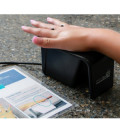Medical Device EMR Integration Could Save 30 Billion
There is an enormous market for medical device integration to EMRs. Unfortunately medical device integration to EMRs face the same common integration challenges as other systems. To achieve these integration goals there needs to be a common interface.
A new report from the West Health Institute (WHI) estimated that improving interoperability between medical devices and electronic health records (EHRs) in hospitals could save more than $30 billion a year while improving patient care and safety.
Among the sources of these savings, the report said, are increased capacity for treatment as a result of shorter lengths of stay ($18 billion); increased clinician productivity because of less time spent entering device data manually into EHRs ($12 billion); avoidance of redundant testing ($3 billion); and the reduction of adverse events because of “safety interlocks” ($2 billion).
Joseph M. Smith, MD, chief medical and science officer of WHI, presented the study in testimony before the House Energy and Commerce subcommittee. He also suggested regulatory and policy changes that he said could help create the conditions for interoperable systems that encompass medical device data. But in an interview with InformationWeek Healthcare, he said he hoped that the impetus for interoperability would come from the private sector.
The WHI report cited a recent study by HIMSS Analytics that said more than 90% of hospitals use six or more types of devices that could be integrated with EHRs. Examples include defibrillators, electrocardiographs, vital signs monitors, ventilators and infusion pumps. Yet only a third of hospitals integrate any medical devices with EHRs, and those that do, on average, integrate only three types of devices.
One reason for this limited interoperability, the report pointed out, is the lack of standardization of interfaces between devices and EHRs. This creates high cost and complexity that deters many providers from investing in this capability. The cost of medical device integration, the report stated, can range from $6,500 to $10,000 per bed in one-time costs, plus up to 15% of that in annual maintenance costs.
The medical device makers have little incentive to standardize their interfaces. For one thing, the report noted, 93% of the financial benefits would accrue to healthcare providers and none to the device vendors. Also, Smith said, the device companies benefit from having their devices communicate only with other machines from the same vendor, which protects their market share. Conversely, if standard interfaces became the norm, the barriers to entry for entrepreneurial firms would decline, which could potentially lead to greater competition for the big device firms.
But, if these objections could be overcome, along with distrust between vendors that might not want their devices to communicate for safety reasons, there could be significant benefits from interoperability, the report said. For example, adverse drug events related to IV administration could be reduced by a third, saving $1.3 billion. Other adverse events stemming from missed diagnoses could also drop significantly, saving $466 million a year, the report said.
Alerts from bedside monitoring devices could be much more relevant than they are today if devices interoperated with EHRs and each other, Smith noted. Currently, clinicians often ignore beeping monitors in the hospital because of alert fatigue. Automation and “local control” features could help minimize that, he said.
He cited a situation where a post-surgical patient might be getting too much pain medication through an infusion pump. “If that infusion pump is simultaneously aware of your pulse oximetry or aware of the pad under your bed that’s measuring your respiratory rate or aware of the output from a CO2 monitor around your nose, there’s a possibility of a safety interlock, where the device decides, ‘this patient has had enough,’ and alerts the nurses. If you function that way, you take out the delay and you don’t burden the clinicians.”
Smith would also like to see lab results pushed automatically to EHRs. While this is supposed to happen in hospitals that have computerized physician order entry (CPOE), he noted, point-of-care devices that quickly do a urinalysis in the emergency department, for example, don’t have that capability. These devices require manual data entry. So do vital signs machines that are not hooked up to EHRs.
The report also suggested that nurse time spent programming infusion pumps could be greatly reduced if the pumps were programmed automatically, using “provider-ordered and pharmacist-validated infusion variables.”
Smith said he’s not worried about automating a process that has the potential to harm patients if not performed correctly every time. “What we’re trying to do is not lose the oversight, but reduce the error,” he noted. “We’ve shown we can do that with CPOE systems, so it’s just a question of extending it all the way to the patient.”
Click here to read the original article about Medical Device EMR integration









You must be logged in to post a comment Login